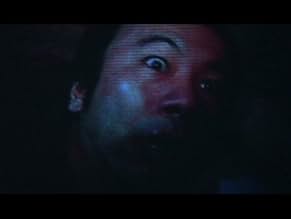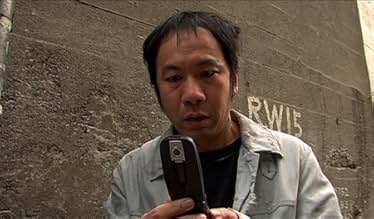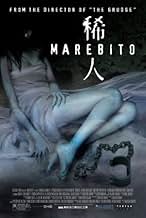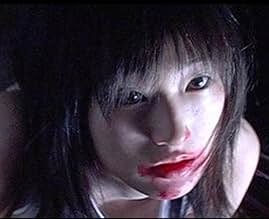NOTE IMDb
6,0/10
5,9 k
MA NOTE
Ajouter une intrigue dans votre langueA fear-obsessed freelance cameraman (Shinya Tsukamoto) investigates an urban legend involving mysterious spirits that haunt the subways of Tokyo.A fear-obsessed freelance cameraman (Shinya Tsukamoto) investigates an urban legend involving mysterious spirits that haunt the subways of Tokyo.A fear-obsessed freelance cameraman (Shinya Tsukamoto) investigates an urban legend involving mysterious spirits that haunt the subways of Tokyo.
- Réalisation
- Scénario
- Casting principal
- Récompenses
- 2 victoires et 1 nomination au total
Avis à la une
This is a marvelous movie.
More than a psychological abyss than a straight horror, this little dagger stabs deeper than most of the pretentious psycho thrillers will ever.
Although this masterpiece is not for everyone. It offers a bunch of pretty disturbing scenes, but one has to watch it at least twice, in order to fully comprehend it's twisted metaphoric.
If you find this movie weird, just stop and think about how weirder is the whole mankind. Instead. Horrible thurths are revealed through this genius metaphor of vampyrism.
Cult director Shinya Tsukamoto (whom I'm a devotee) gives the hell out of a performance. This guy is either crazy, either true genius, either both. I'I'm so very impressed.
And a la fin, a quote from marebito: "Horror, is actually an ancient wisdom that we find deep in the memory of our souls....."
More than a psychological abyss than a straight horror, this little dagger stabs deeper than most of the pretentious psycho thrillers will ever.
Although this masterpiece is not for everyone. It offers a bunch of pretty disturbing scenes, but one has to watch it at least twice, in order to fully comprehend it's twisted metaphoric.
If you find this movie weird, just stop and think about how weirder is the whole mankind. Instead. Horrible thurths are revealed through this genius metaphor of vampyrism.
Cult director Shinya Tsukamoto (whom I'm a devotee) gives the hell out of a performance. This guy is either crazy, either true genius, either both. I'I'm so very impressed.
And a la fin, a quote from marebito: "Horror, is actually an ancient wisdom that we find deep in the memory of our souls....."
First off, I hated Ju-On. I thought it was derivative garbage of the J-horror variety (most J-Horror, which many American's think is "cult", is the equivalent of teen slasher flicks in their respective countries). That said, I was expecting nothing from this film. Instead, I got a Japanese David Cronenberg film, for all intents and purposes. This film would make an excellent companion piece to Cronenberg's Videodrome.
Both deal with technology and alienation in an urban setting. While in Videodrome it's the proliferation of mass media that causes the protagonists reality slip, here it's the creation of such media. The main character is a freelance videographer who makes a living filming the horrible things that people do to each other (and themselves) in the crowded yet isolated world of the big city. He eventually comes to understand that nothing is more cruel than what he does. He is, in a figurative sense, a vampire. He sucks the blood of the living into his lens, and thrives off the rewards. But he is lost.
Then he meets...a girl? A creature? A vampire? A hallucination? The fact that she has no recognizable emotion or attachment, and lives only to feed on the blood of people is a projection of what he is so ashamed of.
This film really gets into the feel of alienation (much the way "Clean, Shaven" and Cronenberg's "Spider" did) and makes you feel the way the populace who views his videos do. Disturbed, but secretly glad and thrilled that misery was put on film.
Which leads me to the presentation. Many have griped about the Digital Film approach, which, as most cinephiles know, leads to a harsh lighting scheme and stark contrasts- none of the lushness of film- and jerky movement feel. Shimizou could have easily done this on film if he had wanted to, but instead, I feel, made a choice to use digital...it's the same format that his protagonist records horrible images on. One turn deserves another. I enjoyed this aspect, as the presentation aspect of a film is rarely intrinsic to both the style and subtext of the film.
That said, it's not entirely successful. A few scenes could have used better FX work or shot choice/editing, but, hey, he shot this on the fly in 8 days, on his way to make another J-Horror "scary-kid" schlockfest. This film shows he is more capable than that. Fans of J-horror may want to avoid this, whereas if, like me, you're a fan of shock-cinema and narrative surrealism (Lynch, some Cronenberg, you) may enjoy this.
Both deal with technology and alienation in an urban setting. While in Videodrome it's the proliferation of mass media that causes the protagonists reality slip, here it's the creation of such media. The main character is a freelance videographer who makes a living filming the horrible things that people do to each other (and themselves) in the crowded yet isolated world of the big city. He eventually comes to understand that nothing is more cruel than what he does. He is, in a figurative sense, a vampire. He sucks the blood of the living into his lens, and thrives off the rewards. But he is lost.
Then he meets...a girl? A creature? A vampire? A hallucination? The fact that she has no recognizable emotion or attachment, and lives only to feed on the blood of people is a projection of what he is so ashamed of.
This film really gets into the feel of alienation (much the way "Clean, Shaven" and Cronenberg's "Spider" did) and makes you feel the way the populace who views his videos do. Disturbed, but secretly glad and thrilled that misery was put on film.
Which leads me to the presentation. Many have griped about the Digital Film approach, which, as most cinephiles know, leads to a harsh lighting scheme and stark contrasts- none of the lushness of film- and jerky movement feel. Shimizou could have easily done this on film if he had wanted to, but instead, I feel, made a choice to use digital...it's the same format that his protagonist records horrible images on. One turn deserves another. I enjoyed this aspect, as the presentation aspect of a film is rarely intrinsic to both the style and subtext of the film.
That said, it's not entirely successful. A few scenes could have used better FX work or shot choice/editing, but, hey, he shot this on the fly in 8 days, on his way to make another J-Horror "scary-kid" schlockfest. This film shows he is more capable than that. Fans of J-horror may want to avoid this, whereas if, like me, you're a fan of shock-cinema and narrative surrealism (Lynch, some Cronenberg, you) may enjoy this.
A strange film by Grudge writer/director Takashi Shimizu.
Shinya Tsukamoto (Ichi the Killer) is consumed with finding out the source of terror that caused a man to stab himself in the eye. He wants to experience the same terror - terror so horrible that it would cause you to want to kill yourself.
He goes underground looking for the beings that inhabit the tunnels under Tokyo and finds a naked girl, who he brings home to live with him. The girls is more animal than human and he kills to provide her blood rather than give her his own blood, which she wants.
It is not certain throughout whether he is going mad or finding what he is searching for. He even tries to escape, but resumes the search until he finally succumbs to the terror.
Despite the shaky camera work, which some like, but which distracts me, it was a fascinating look at terror and certainly a film that contains much more than available at first glance. A blend of mysticism and horror, it is a worthy view for fans of Japanese horror.
Shinya Tsukamoto (Ichi the Killer) is consumed with finding out the source of terror that caused a man to stab himself in the eye. He wants to experience the same terror - terror so horrible that it would cause you to want to kill yourself.
He goes underground looking for the beings that inhabit the tunnels under Tokyo and finds a naked girl, who he brings home to live with him. The girls is more animal than human and he kills to provide her blood rather than give her his own blood, which she wants.
It is not certain throughout whether he is going mad or finding what he is searching for. He even tries to escape, but resumes the search until he finally succumbs to the terror.
Despite the shaky camera work, which some like, but which distracts me, it was a fascinating look at terror and certainly a film that contains much more than available at first glance. A blend of mysticism and horror, it is a worthy view for fans of Japanese horror.
This was just a strange movie, but not in a cool way, like Forbidden Zone, or Uzumaki. Just weird.
All I can say is that a creepy voyeur cameraman sees a guy commit suicide by stabbing himself, and wonders what he had seen that made him so terrified. Any more said would ruin it.
Sure, the acting by the guy was good, and you never know what is going to happen next, and it is well shot, but it is ultimately boring, and the ending doesn't satisfy you. I did enjoy it on some level, but by the end, I was ready to stop watching.
6/10
All I can say is that a creepy voyeur cameraman sees a guy commit suicide by stabbing himself, and wonders what he had seen that made him so terrified. Any more said would ruin it.
Sure, the acting by the guy was good, and you never know what is going to happen next, and it is well shot, but it is ultimately boring, and the ending doesn't satisfy you. I did enjoy it on some level, but by the end, I was ready to stop watching.
6/10
Thanks to his series of ghost stories, "Ju-on", Japanese director Takashi Shimizu has become one of the most recognized names of the New Wave of Asian horror cinema, the movement of young Asian directors that since the late 90s has produced some of the best and most original horror movies of the last years. The enormous success of his "Ju-on" series took Shimizu to the U.S., in order to direct a remake of the third installment of the series ("Ju-on: The Grudge"), named simply as "The Grudge"; but right before working on the remake, Shimizu took some days with fellow director Shinya Tsukamoto and a small crew to make a very low-budget horror movie, pretty much on the style he used to make when "Ju-on" was a straight to video release, but this time with a very different kind of story.
Masuoka (Shinya Tsukamoto) is a freelance cameraman almost completely detached from the world and entirely focused on his preference for videotaping and doing camera-work. Onde day, he accidentally tapes the suicide of a man named Arei Furoki (Kazuhiro Nakahara) on a subway station. The strange characteristics of this event, makes Masuoka to be obsessed with the idea of a fear so powerful that only death can erase, so in an attempt to understand Furoki's fear he descends into the underground tunnels of Tokio, discovering the entrance to a bizarre cavern that seems like a passage to the underworld. Is in this caverns where he finds a naked girl (Tomoi Miyashita) chained to the wall. He unchains her and takes her to his apartment, but soon he discovers that this girl (whom he names "F") is not a normal person, and that her presence in his world will make a darker side of him to come out.
"Marebito" was written by Chiaki Konaka (better known as the writer of the famous anime, "Serial Experiments Lain"), and like most of his works, it is a dark psychological story with a slight cometary on the relationship between humans and the technology they produce. Narrated by Masuoka, the story is told from his perspective, so we are taken along him through his discovery of mysteries that should be better kept secret and the terrific consequences of his actions. It is very Lovecraftian in the sense that, like in the stories by H.P. Lovecraft, we have a main character who may not be entirely sane, and whom his curiosity takes him to the darker sides of human nature. His relationship with the strange girl "F", and his attempts to establish communication with her become the focal point of the plot of "Marebito", although like in other works by Konaka, reality is not always what it seems.
It seems that this "return to roots" was really beneficial for Takashi Shimizu, as the work he offers in "Marebito" is once again a very fresh and original horror movie that proves that there is more in this young director than the "Ju-on" series. By working again on a shoestring budget, Shimizu is able to capture the simple and monotone life of Masuoka, and with the use of digital video he mimics the world as his main character sees it: a world through the camera lens. While the movie moves at a very slow pace, it really is an improvement over the style of using disjointed story lines in "Ju-on", and never falls into the trap of being boring or repetitive (a common flaw of the "Ju-on" movies). However, a trait kept from "Ju-on", is Shimizu's skill to create ominous haunting atmospheres with common everyday objects, this time, the video screens and what's on them is the focus of the film.
Shinya Tsukamoto is better known as the director of the remarkable and influential films like "Tetsuo" (1989) and "Tokyo Fist" (1995), but here he offers his talents as an actor in a film where he plays the main character. While a very talented director, Tsukamoto is not really a great actor, and both he and Shimizu seem to be aware of that, so his portrait of Masuoka is conceived as a typical man with obsessive behavior, entering the unknown. The movie's highlight is Tomomi Miyashita, who gives life to the feral child "F", with a frighteningly believable performance that definitely gives the chills. Kazuhiro Nakahara, Miho Ninagawa and Shun Sugata appear in supporting roles, but their appearances are limited, as the movie focuses entirely on Masuoka and the consequences of his relationship with "F".
"Marebito" is an excellent example of how imagination and a good plot can make a film work even with the most limited resources. Of course, the movie suffers the most in the special effects department, with some of the visuals looking painfully amateurish (although probably that was the intention). The use of digital camera may be annoying to those expecting a good looking film, but instead of being a flaw, its use in the film gives the story a realistic tone, as if we were really watching a person's descent into madness. Some people have criticized the convoluted plot of Konaka's story, filled with many details and references that often make no sense or have twisted meanings in the movie; however, I find the storyline captivating because of that unpredictability, and the fact that Shimizu moves away from the ghost stories that have become typical of Asian horror is really refreshing.
With his "Ju-on" ghost stories, Takashi Shimizu became known worldwide as a major horror director, but personally I think that "Marebito" is the movie that truly reveals him as a horror author. It's not a movie destined to be a hit, but it's one that shows a different take on horror and while maybe "The Grudge" is the movie that most people relate to Shimizu, but personally, I think that "Marebito" is a much better and more satisfying movie. 8/10
Masuoka (Shinya Tsukamoto) is a freelance cameraman almost completely detached from the world and entirely focused on his preference for videotaping and doing camera-work. Onde day, he accidentally tapes the suicide of a man named Arei Furoki (Kazuhiro Nakahara) on a subway station. The strange characteristics of this event, makes Masuoka to be obsessed with the idea of a fear so powerful that only death can erase, so in an attempt to understand Furoki's fear he descends into the underground tunnels of Tokio, discovering the entrance to a bizarre cavern that seems like a passage to the underworld. Is in this caverns where he finds a naked girl (Tomoi Miyashita) chained to the wall. He unchains her and takes her to his apartment, but soon he discovers that this girl (whom he names "F") is not a normal person, and that her presence in his world will make a darker side of him to come out.
"Marebito" was written by Chiaki Konaka (better known as the writer of the famous anime, "Serial Experiments Lain"), and like most of his works, it is a dark psychological story with a slight cometary on the relationship between humans and the technology they produce. Narrated by Masuoka, the story is told from his perspective, so we are taken along him through his discovery of mysteries that should be better kept secret and the terrific consequences of his actions. It is very Lovecraftian in the sense that, like in the stories by H.P. Lovecraft, we have a main character who may not be entirely sane, and whom his curiosity takes him to the darker sides of human nature. His relationship with the strange girl "F", and his attempts to establish communication with her become the focal point of the plot of "Marebito", although like in other works by Konaka, reality is not always what it seems.
It seems that this "return to roots" was really beneficial for Takashi Shimizu, as the work he offers in "Marebito" is once again a very fresh and original horror movie that proves that there is more in this young director than the "Ju-on" series. By working again on a shoestring budget, Shimizu is able to capture the simple and monotone life of Masuoka, and with the use of digital video he mimics the world as his main character sees it: a world through the camera lens. While the movie moves at a very slow pace, it really is an improvement over the style of using disjointed story lines in "Ju-on", and never falls into the trap of being boring or repetitive (a common flaw of the "Ju-on" movies). However, a trait kept from "Ju-on", is Shimizu's skill to create ominous haunting atmospheres with common everyday objects, this time, the video screens and what's on them is the focus of the film.
Shinya Tsukamoto is better known as the director of the remarkable and influential films like "Tetsuo" (1989) and "Tokyo Fist" (1995), but here he offers his talents as an actor in a film where he plays the main character. While a very talented director, Tsukamoto is not really a great actor, and both he and Shimizu seem to be aware of that, so his portrait of Masuoka is conceived as a typical man with obsessive behavior, entering the unknown. The movie's highlight is Tomomi Miyashita, who gives life to the feral child "F", with a frighteningly believable performance that definitely gives the chills. Kazuhiro Nakahara, Miho Ninagawa and Shun Sugata appear in supporting roles, but their appearances are limited, as the movie focuses entirely on Masuoka and the consequences of his relationship with "F".
"Marebito" is an excellent example of how imagination and a good plot can make a film work even with the most limited resources. Of course, the movie suffers the most in the special effects department, with some of the visuals looking painfully amateurish (although probably that was the intention). The use of digital camera may be annoying to those expecting a good looking film, but instead of being a flaw, its use in the film gives the story a realistic tone, as if we were really watching a person's descent into madness. Some people have criticized the convoluted plot of Konaka's story, filled with many details and references that often make no sense or have twisted meanings in the movie; however, I find the storyline captivating because of that unpredictability, and the fact that Shimizu moves away from the ghost stories that have become typical of Asian horror is really refreshing.
With his "Ju-on" ghost stories, Takashi Shimizu became known worldwide as a major horror director, but personally I think that "Marebito" is the movie that truly reveals him as a horror author. It's not a movie destined to be a hit, but it's one that shows a different take on horror and while maybe "The Grudge" is the movie that most people relate to Shimizu, but personally, I think that "Marebito" is a much better and more satisfying movie. 8/10
Le saviez-vous
- AnecdotesTakashi Shimizu shot the film in just eight days, between the production dates for Ju-on: The Grudge (2002) and its remake, The Grudge (2004).
Meilleurs choix
Connectez-vous pour évaluer et suivre la liste de favoris afin de recevoir des recommandations personnalisées
- How long is Marebito?Alimenté par Alexa
Détails
Box-office
- Budget
- 5 000 000 JPY (estimé)
- Montant brut aux États-Unis et au Canada
- 13 983 $US
- Week-end de sortie aux États-Unis et au Canada
- 3 852 $US
- 11 déc. 2005
- Montant brut mondial
- 107 259 $US
- Durée1 heure 32 minutes
- Couleur
- Rapport de forme
- 1.85 : 1
Contribuer à cette page
Suggérer une modification ou ajouter du contenu manquant



























